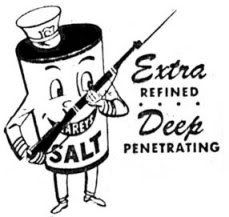
"Salt is a substance near to the Gods." - Plato
Today we went to the Kansas Underground Salt Museum, 650' down in the ground (through 120' feet in water!) to the so-called Permian layer. The mine, founded in 1887, is jointly the location of the Hutchinson Salt Company (formerly the Carey Salt Mine) and Underground Vaults and Storage, Inc., a storage facility for film, medical documents, artwork and artifacts.A 1950's postcard of the mine:

This salt deposit is one of the largest deposits known in the world, 4,000 square miles in area, covering parts of Kansas, Oklahoma, and Texas. The museum is the only of its kind in the United States. With more than 67 miles of mined caverns, the salt mine produces 500,000 tons of rock salt each year, with approximately 80% used for road deicing and 20% used for cattle supplements. Rock salt is 95% halite and contains shale and other impurities. Today, the mine employs only 5 miners per shift, with an additional 5 employees serving as drillers, mechanics, explosive experts, etc.
Cool formations on the mine's walls:

An additional 65-70 employees work for Underground Vaults and Storage. The mine is perfect for storing a variety of artifacts because it is secure and offers a stable year-round temperature of 68° F and constant 42% humidity. All but one of the major Hollywood studios stores their film reels here.
Nearby, the Cargill and Morton plants produce common table salt - mined from the very same salt deposits, as well as salt for many other purposes. Amazingly, there are over 14,000 uses for salt!
Here's a slideshow from our visit:
Labels: Field Trips
0 Comments:
Subscribe to:
Post Comments (Atom)





















